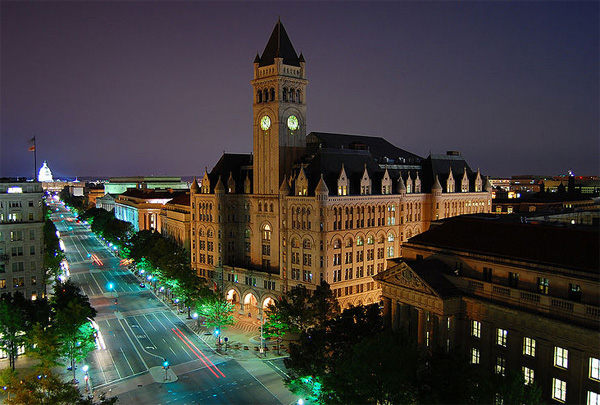GSA Taps Trump for $200M Redevelopment of D.C.'s Old Post Office Building
The U.S. General Services Administration has selected the Trump Organization as its preferred team to handle a $200 million redevelopment of the Old Post Office building and annex in Washington’s Federal Triangle neighborhood, turning the structure into a luxury hotel.
February 9, 2012
By Scott Baltic, Contributing Editor
The U.S. General Services Administration has selected the Trump Organization as its preferred team to handle a $200 million redevelopment of the Old Post Office building and annex in Washington’s Federal Triangle neighborhood, the GSA announced Tuesday. Under the Trump Organization’s proposal, the Old Post Office will, perhaps unsurprisingly, be converted into a luxury hotel with more than 250 rooms, upscale restaurants, a spa and conference facilities, while still preserving the building’s Romanesque Revival architecture.
Under the RFP, GSA and the Trump Organization will spend the next year negotiating a detailed redevelopment agreement that will specify usage, historic-preservation requirements and the federal government’s revenue stream. In the meantime, GSA will relocate the building’s current federal tenants, which include the Advisory Council on Historic Preservation, National Endowment for the Arts and National Endowment for the Humanities.
If negotiations proceed as expected, redevelopment is expected to start in 2014, with occupancy in 2016. At the end of the lease, control of the building will revert to the federal government.
Built between 1892 and 1899, the Old Post Office was already considered old-fashioned when it opened. The D.C. Mail Depot was moved to a larger building in 1914, and in the 1920s the Old Post Office faced demolition.
A lack of money during the Great Depression kept the building open, but in 1964 a federal commission recommended taking the building down. Though demolition permits were issued, historic preservationists fought for the building. In 1973 it was added to the National Register of Historic Places, and an extensive renovation began in 1976.
A generation later, the building had outlived its usefulness as federal office space, and Congress directed GSA in 2008 to enter into a long-term lease under Section 111 of the National Historic Preservation Act, thereby guaranteeing the restoration and retention of all of the building’s historic features, while allowing the private sector to determine how to develop it to its fullest potential.
Although redeveloping historic properties is often perceived as a niche activity, GSA is currently involved in several such projects.
One is in Grand Junction, Colo., where in February 2011 the agency announced plans to turn the 92-year-old Wayne Aspinall Federal Building and Courthouse into the nation’s first net-zero energy usage building on the National Register of Historic Places.
If the redevelopment meets its goals, the building will in the course of a year produce as much energy as it consumes. The project is also aiming for LEED Platinum certification. GSA will install a geothermal heating/cooling system that uses the warmth or cold of the ground to help control temperature. A solar panel array is projected to generate enough energy to balance out the building’s electrical demand.
After the project is completed in January 2013, nine federal agencies will take space in the Aspinall Building.
A vastly bigger GSA historic-redevelopment project is getting under way in D.C.’s southeast quadrant, where a former mental hospital overlooks the Potomac and Anacostia rivers.
The creation of the Department of Homeland Security was the largest restructuring of the federal government since the creation of the Defense Department. Similarly, the $3.4 billion St. Elizabeths project, which will be DHS’ new home, is the largest federal construction project in metro Washington since the Pentagon was built during World War II. St. Elizabeths was established by Congress in 1855 as a government hospital. Currently, the 118-acre east campus is owned by the D.C. government, and the 182-acre west campus is owned by the federal government.
Ground was broken in September 2009 on the new 1.2 million-square-foot headquarters of the U.S. Coast Guard, which is scheduled for completion in 2013. The $450 million building is being funded under the American Recovery and Reinvestment Act of 2009.
Most of the St. Elizabeths project, however, will involve adaptive reuse. GSA will preserve 51 of the 62 buildings on the west campus, while incorporating many sustainable elements. For example, about 80 percent of the roof area on the new buildings will be green. GSA’s goal is to achieve LEED Gold certification.








You must be logged in to post a comment.